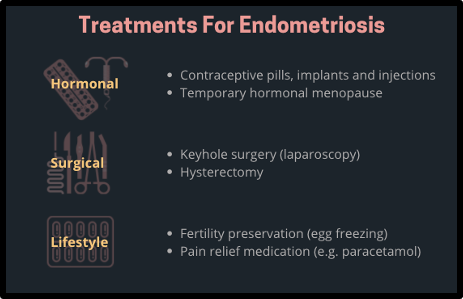The future of endometriosis: how can it be treated?
Over the past month, we have focused on endometriosis: what it is and how to spot the symptoms. If you have done any research at all on the condition, you have probably found out that we know very little about it compared with others.
We know now that this lack of knowledge means that diagnosis takes longer, and symptoms are harder to spot. But, it also means that a cure is still a long way off too. The money raised during QENDO March will help fund research that can help us find a cure.
Even when it comes to treatments, there is a lot of room for improvement, because the most common treatments target the symptoms of endometriosis. Reducing pain and being more comfortable is useful, but it doesn’t help treat or remove the underlying issue.
So, what treatments are there for endometriosis?
Current treatments for endometriosis
The most common treatment – and often the first line of action – is the contraceptive pill. The idea is that suppressing the menstrual cycle will subsequently suppress endometrium growth anywhere in the body. It works, but comes with all the well-known side effects.
Other hormonal contraceptives include injections, implants and the coil. Over-the-counter pain relievers such as paracetamol are also used to treat pain and discomfort caused by endometriosis. Again, these are useful, but they do not help remove endometriosis.
Keyhole surgery on the pelvis – laparoscopy – can help diagnose endometriosis, as well as remove some of the problematic endometrium. Usually, laparoscopy is done in combination with hormone treatments and pain relief.
Hysterectomy is by far the most effective treatment, but it is also the most invasive. It involves removal of the uterus, and sometimes also the fallopian tubes and ovaries. In very extreme cases, a hysterectomy might also remove the upper portion of the vagina.
Many women report difficulty accessing this treatment, as doctors are apprehensive about performing it on women that do not already have children. Even women that never want children are frequently refused a hysterectomy on the basis that they might change their minds.
A hysterectomy causes immediate, certain and irreversible infertility, so is something that should be considered carefully. It is generally only performed on women with extreme pain that is not responsive to any other treatments.
What’s next?
Most treatments for endometriosis are either insufficient or extremely invasive, and there is very little in between. Women with severe endometriosis that would like to have children have very few options when it comes to dealing with their symptoms.
Luckily, research is underway to find something more effective. For women with less severe stages of endometriosis, fertility preservation is possible. Oocyte cryopreservation, for example, allows you to freeze healthy eggs and use them later in life.
As well as searching for better treatments, endometriosis research is looking for its cause. We still aren’t certain what causes endometriosis, or what makes some people suffer more than others.
It is thought to be hormone-related and have a genetic predisposition, which is why having a family member with endometriosis is a risk factor. Also, an environmental cause is the accidental moving of endometrium during pelvic surgery.
The future of endometriosis
With the money and awareness raised during endometriosis awareness month, medical research is in a better position to understand this enigma of a condition. Being so common, more investments are being made into endometriosis research now than ever before.
As always, speak to your doctor if you notice any symptoms. Ask for a pelvic ultrasound and a blood test to check your hormones. If they dismiss your symptoms, it is fine to ask for a second opinion. Extreme period pain is no longer just something women put up with.


